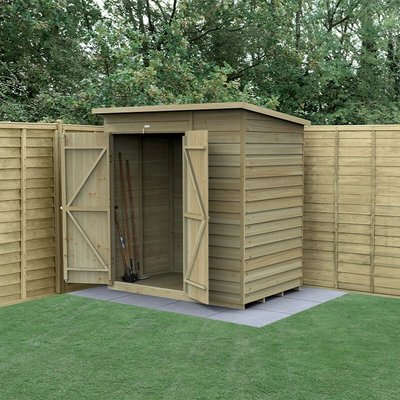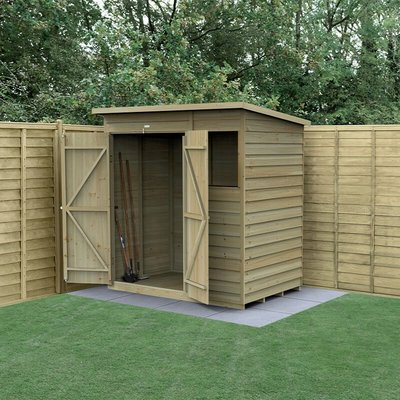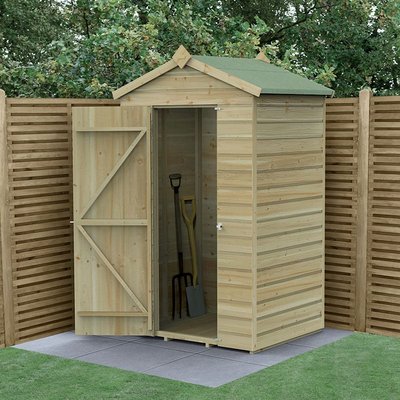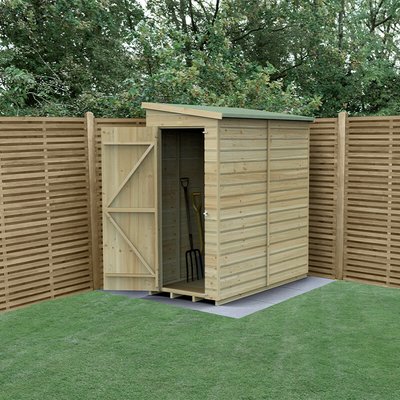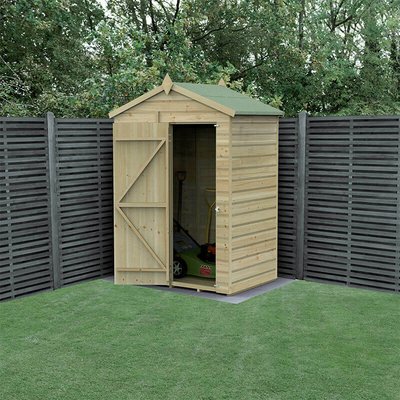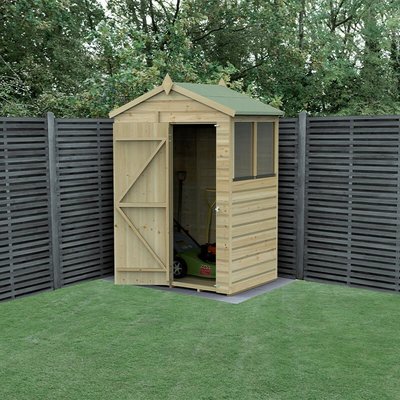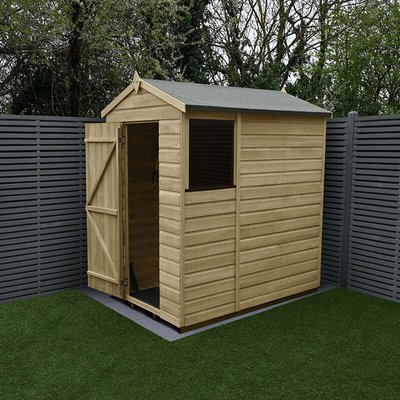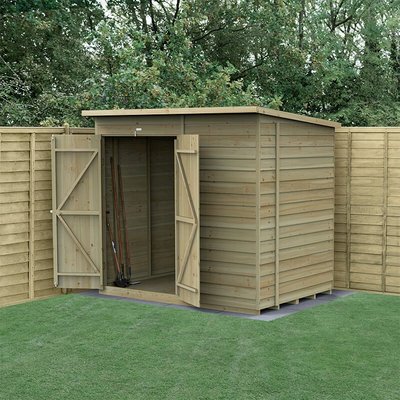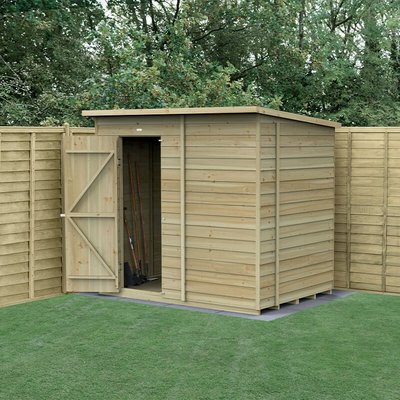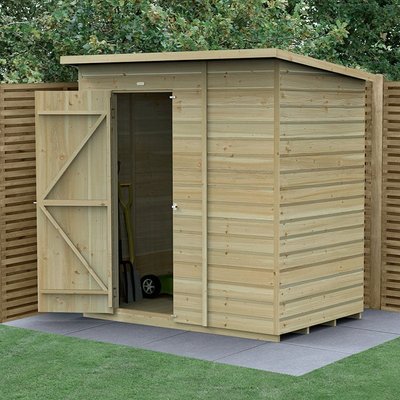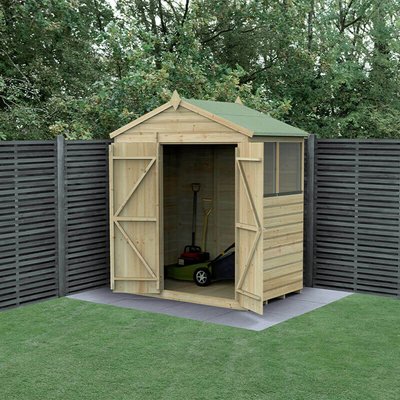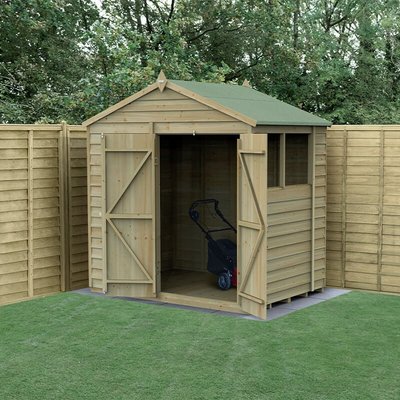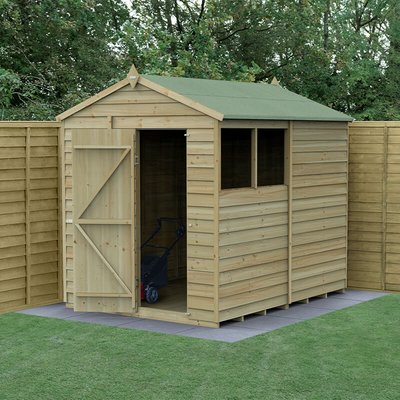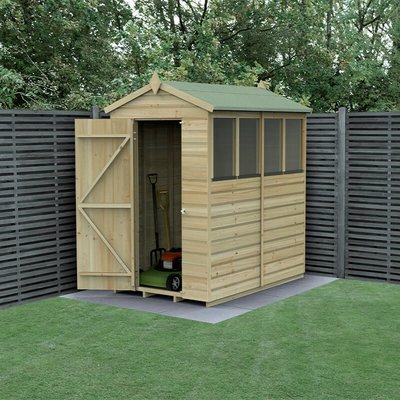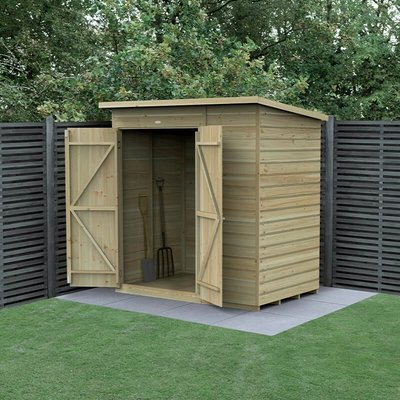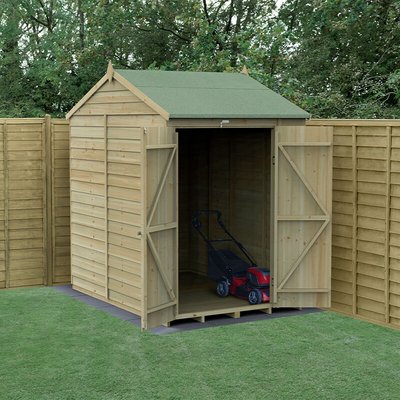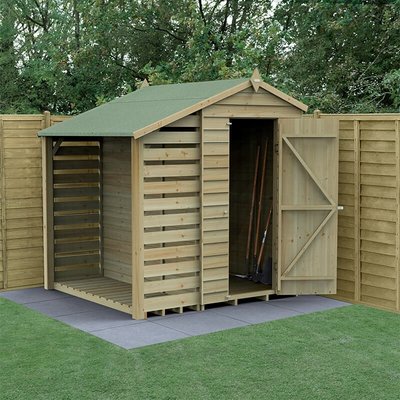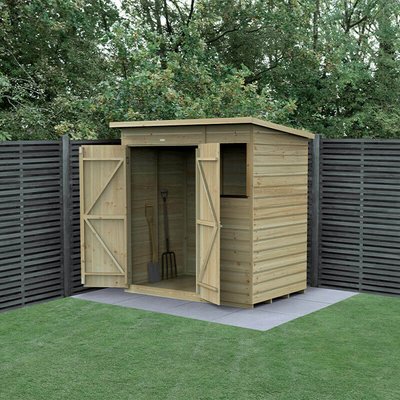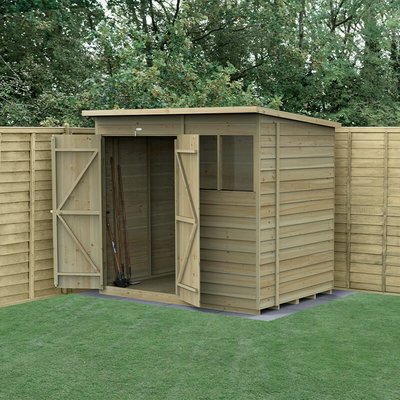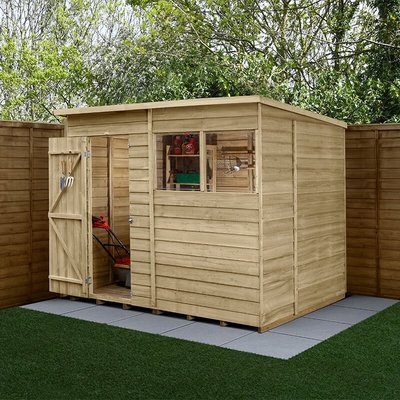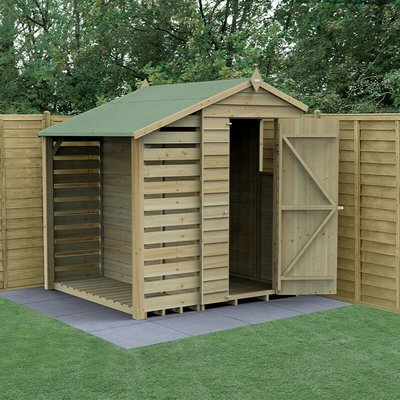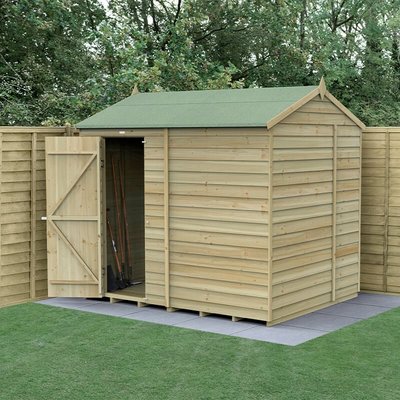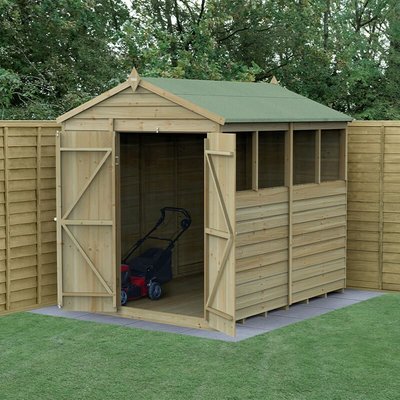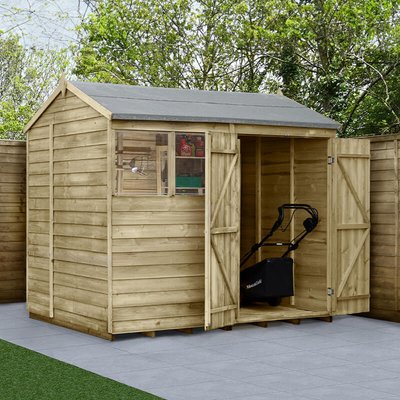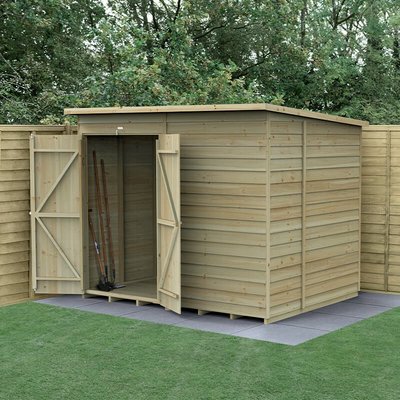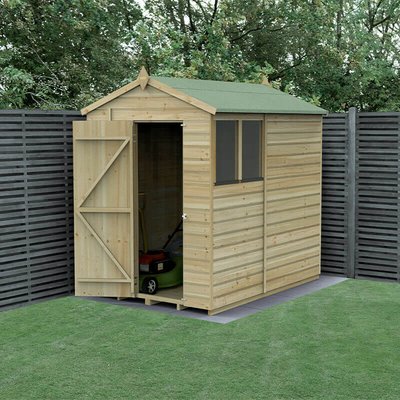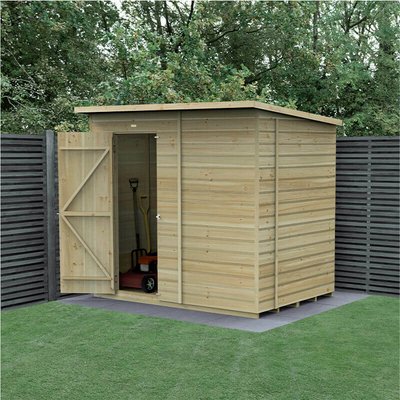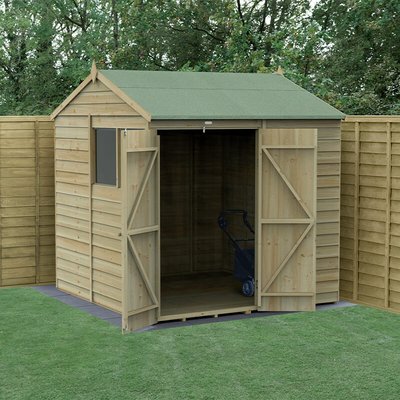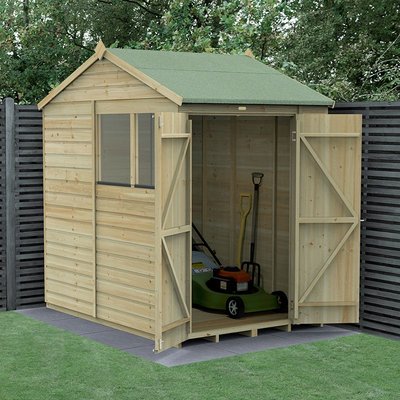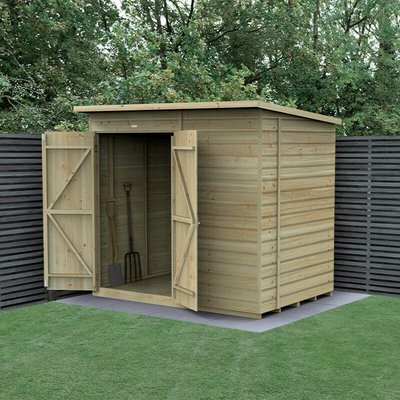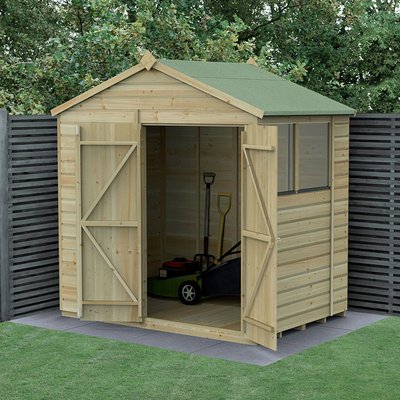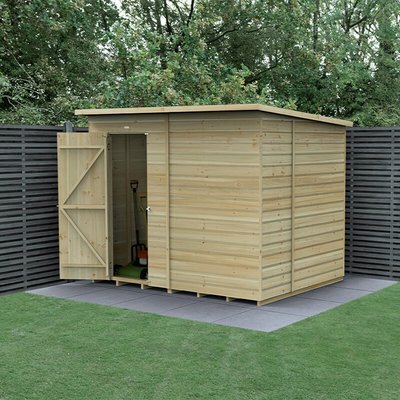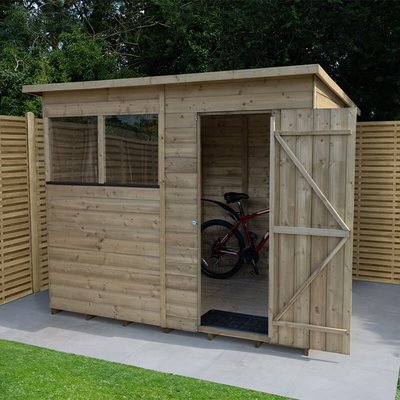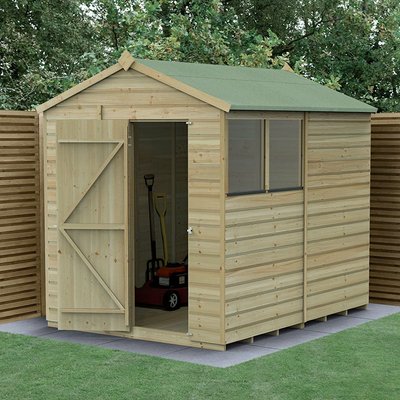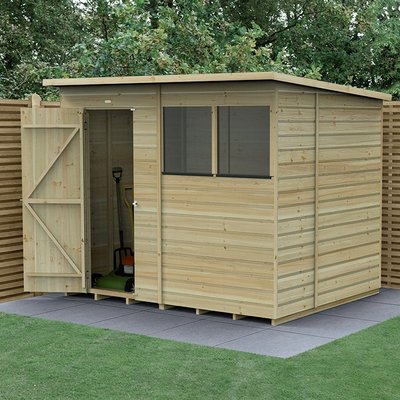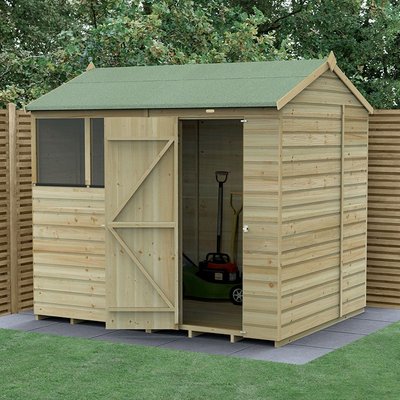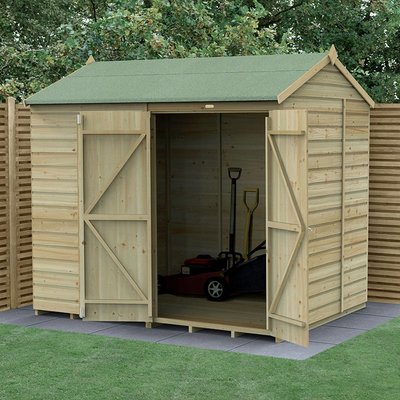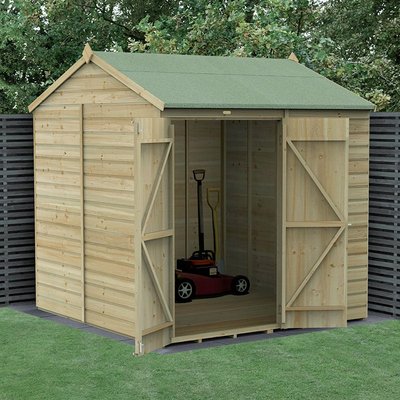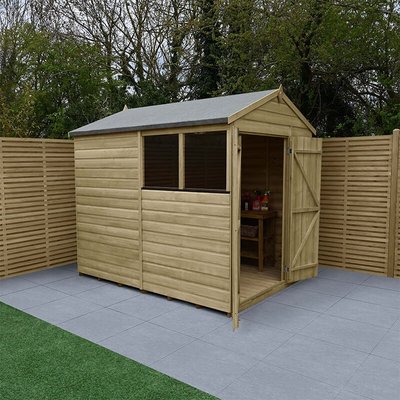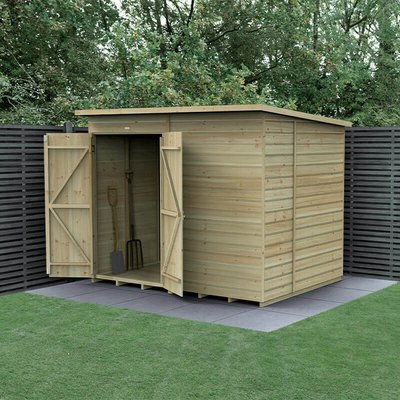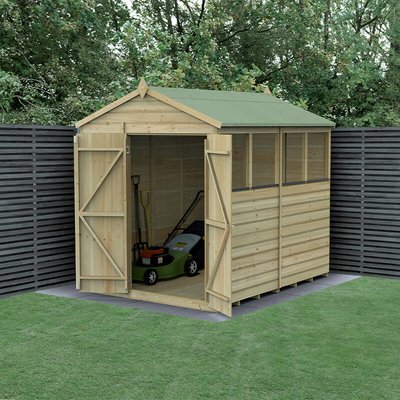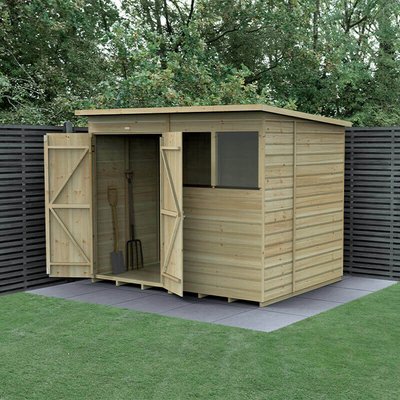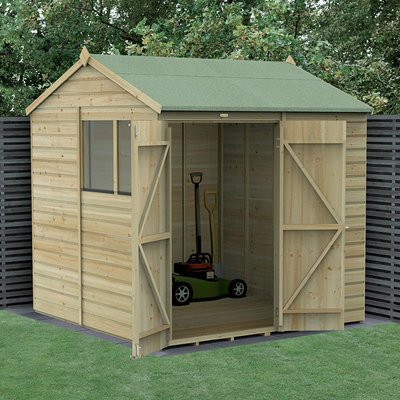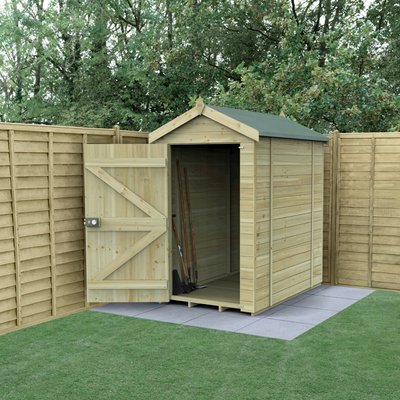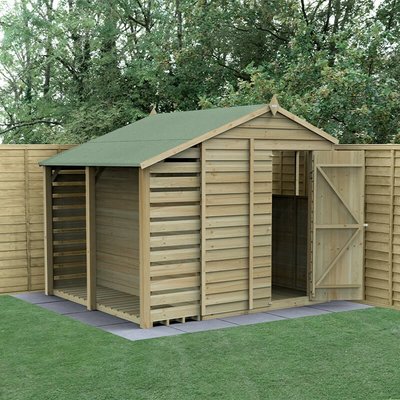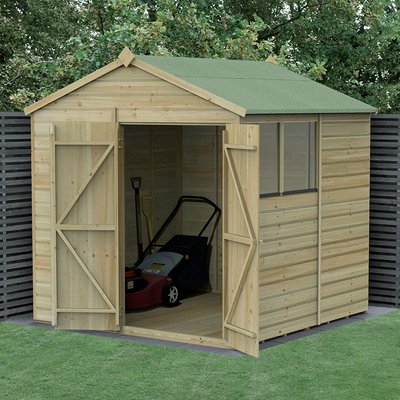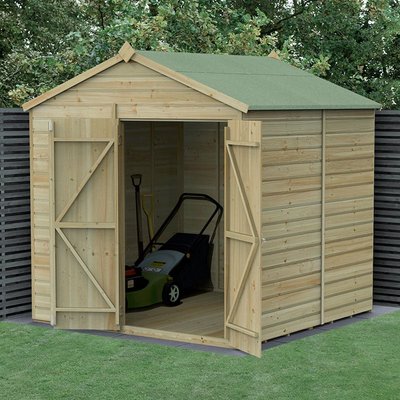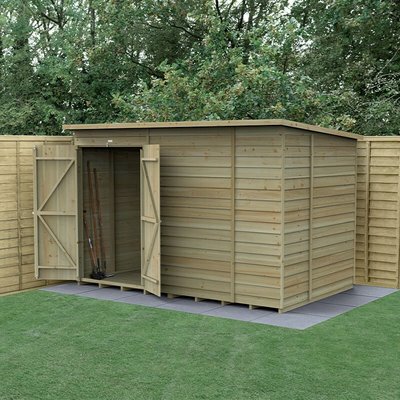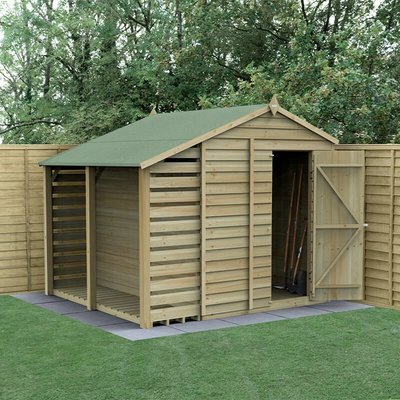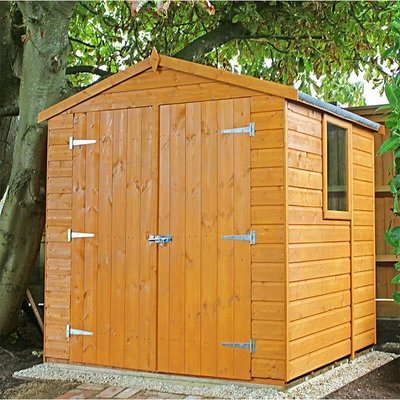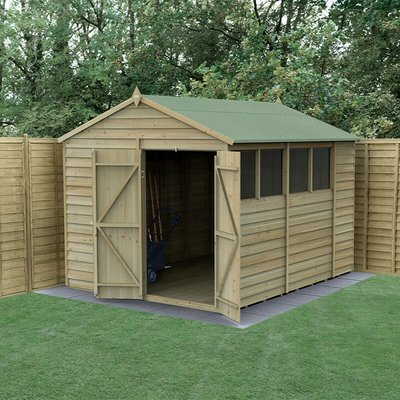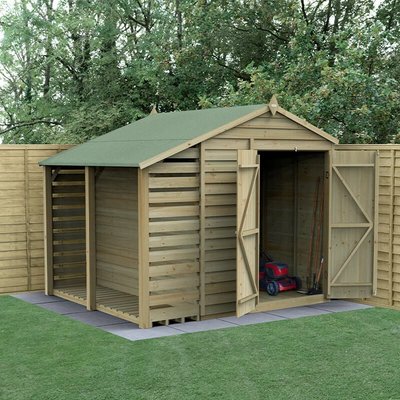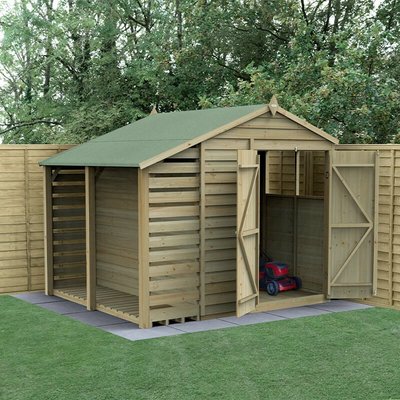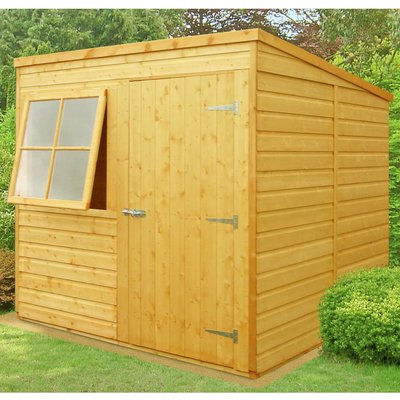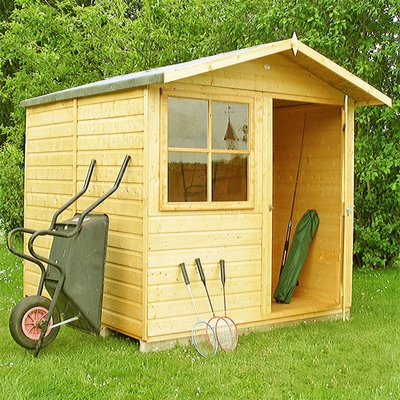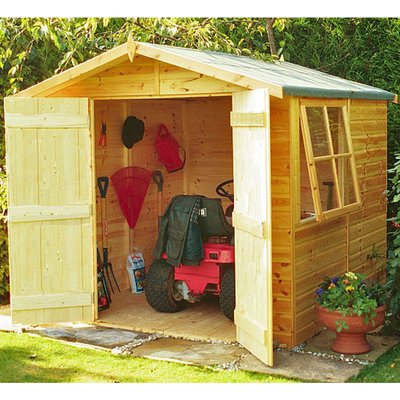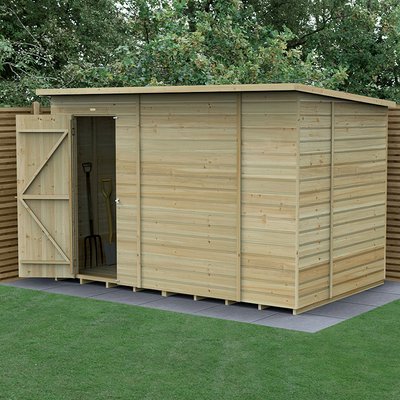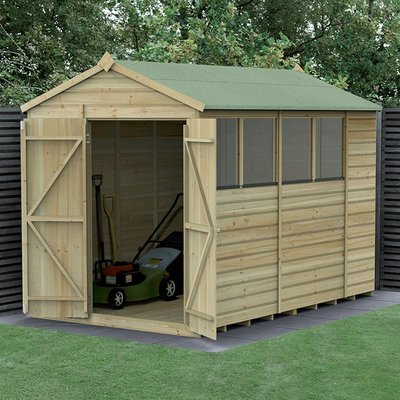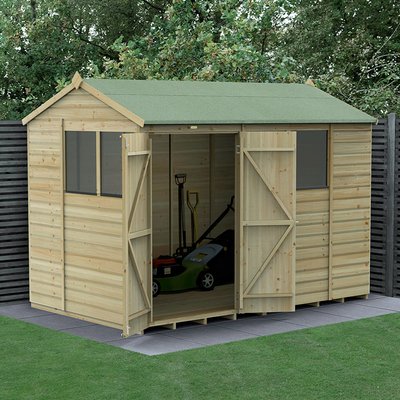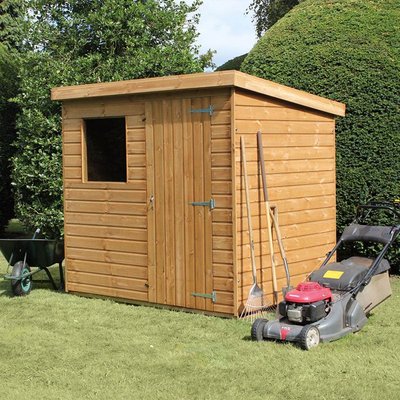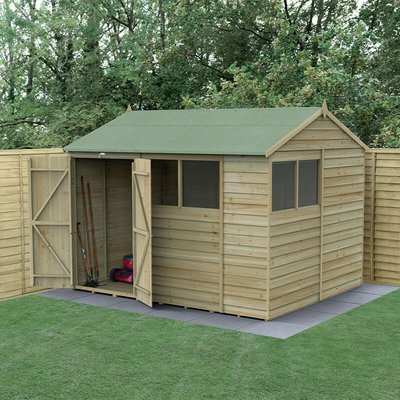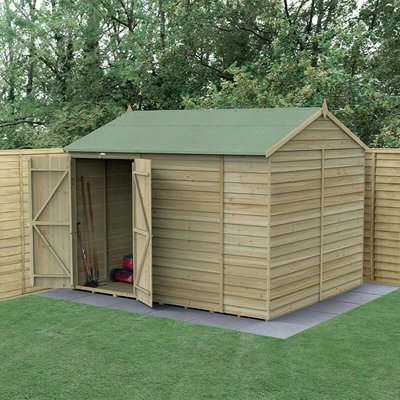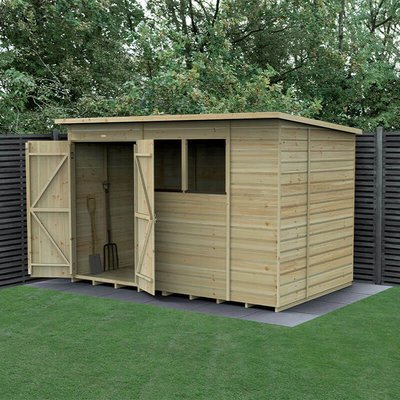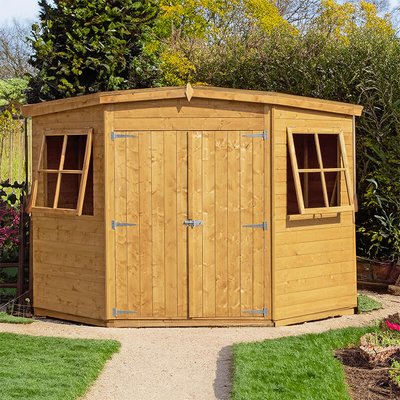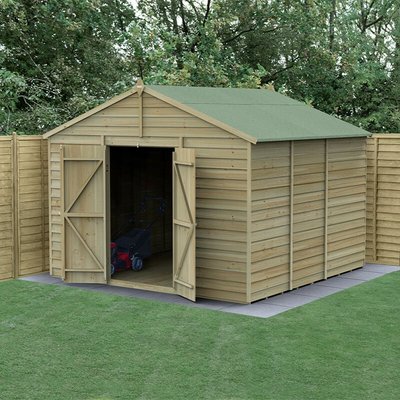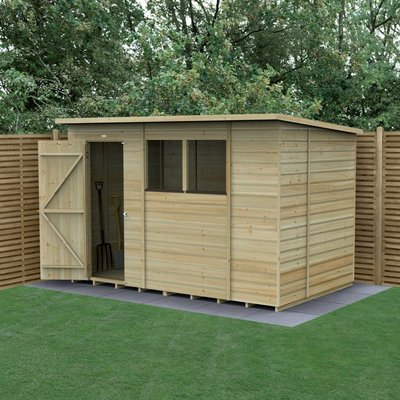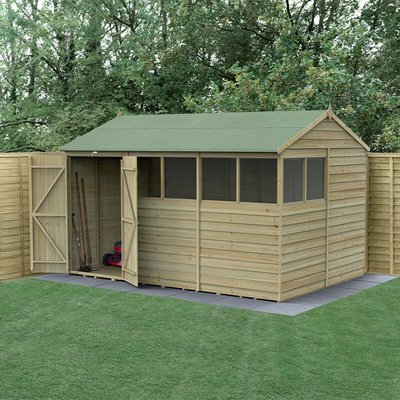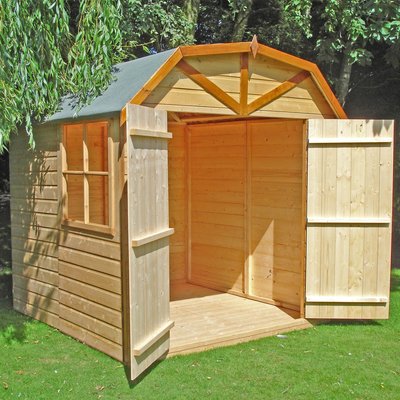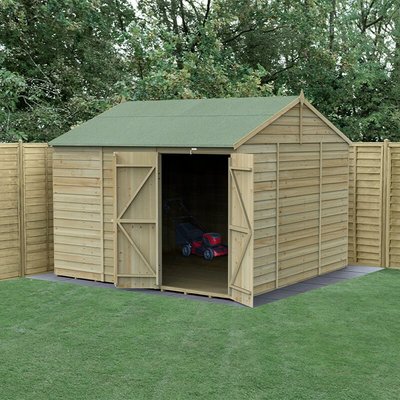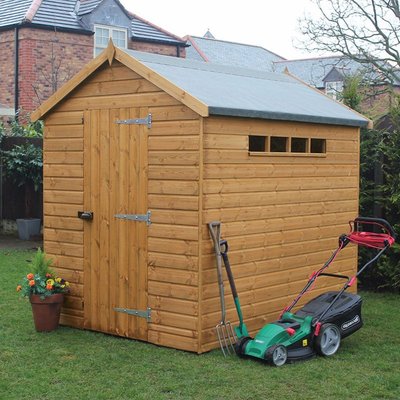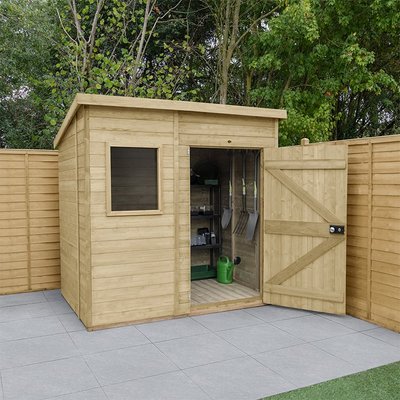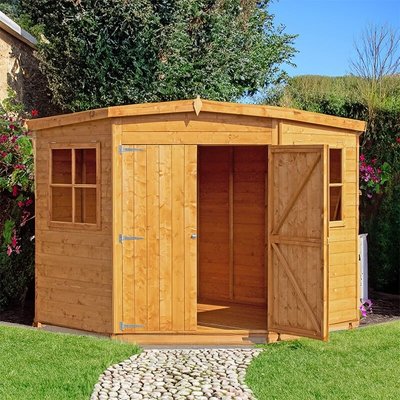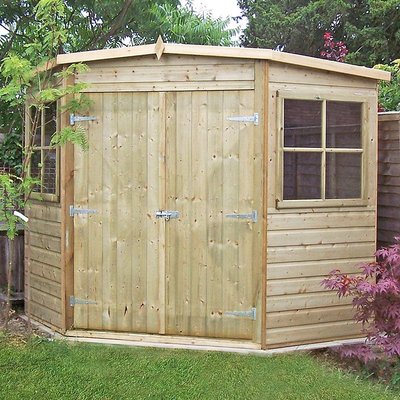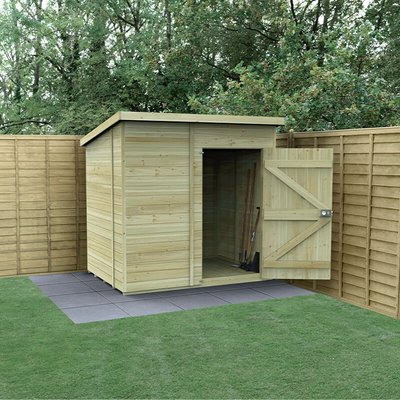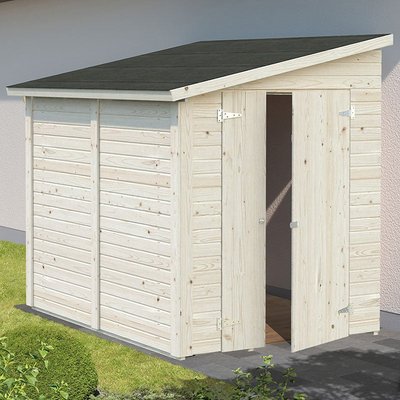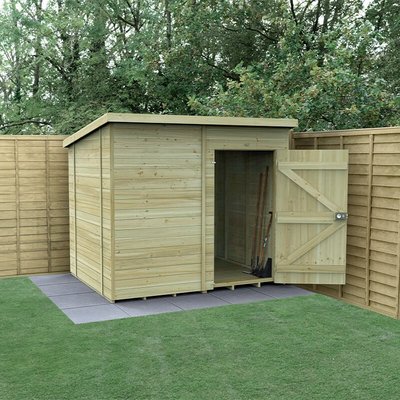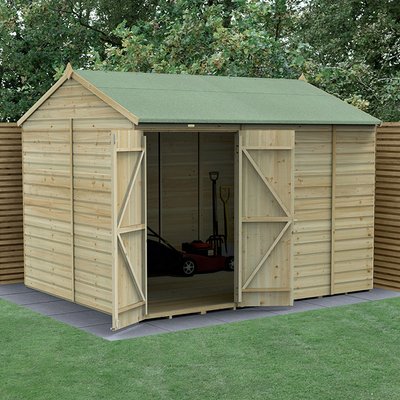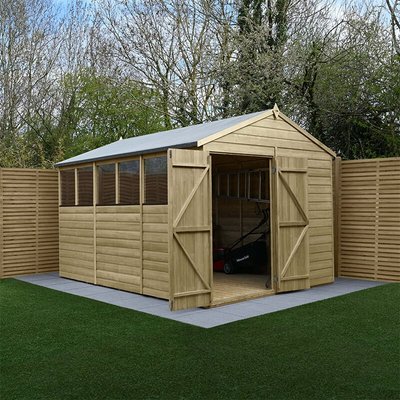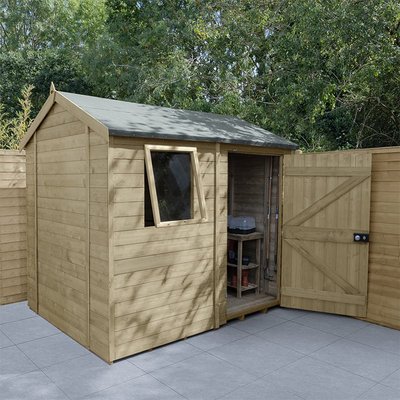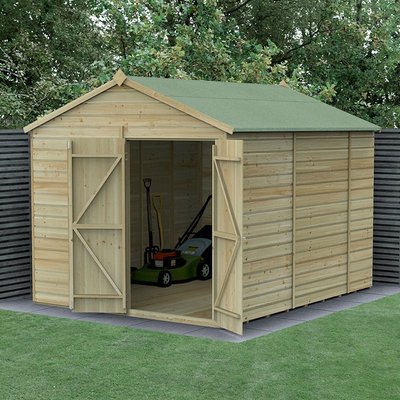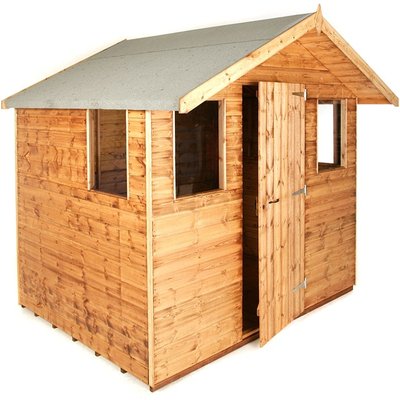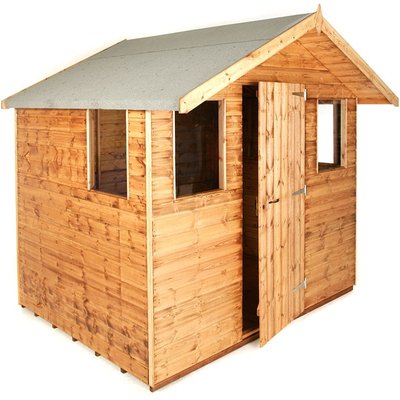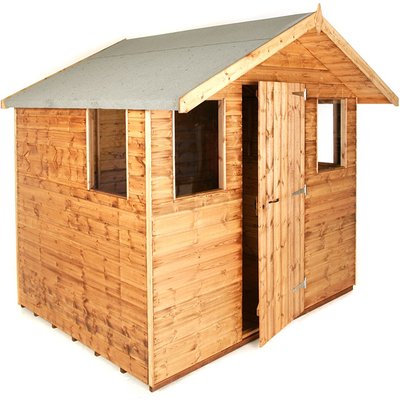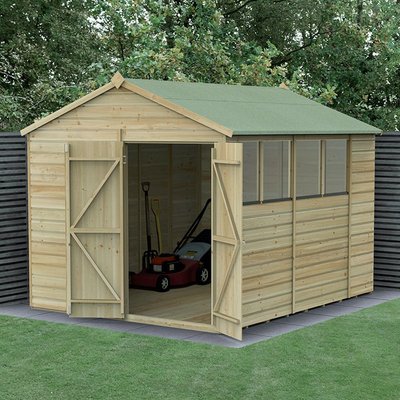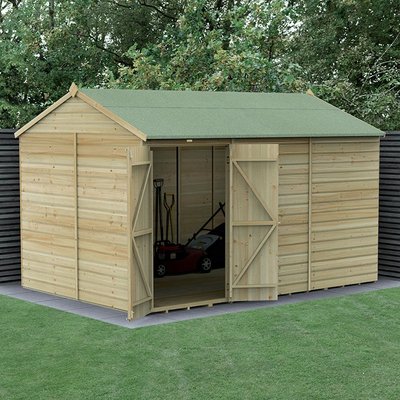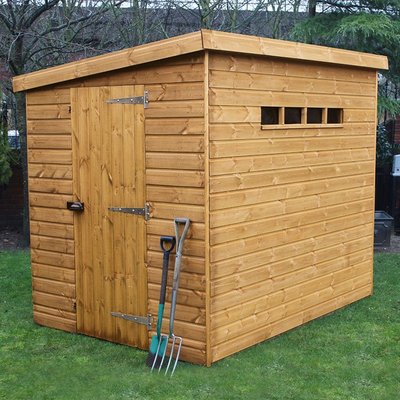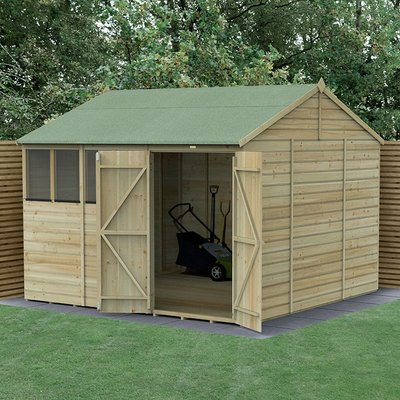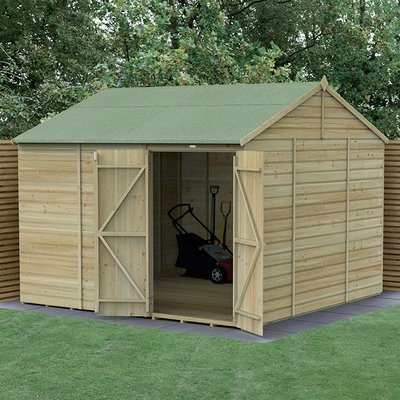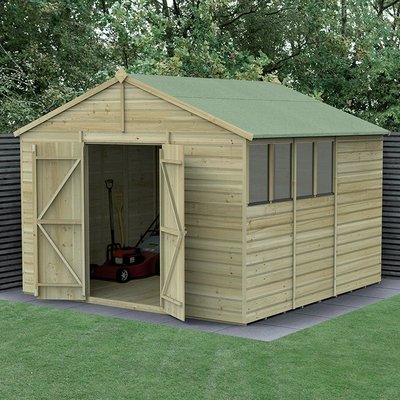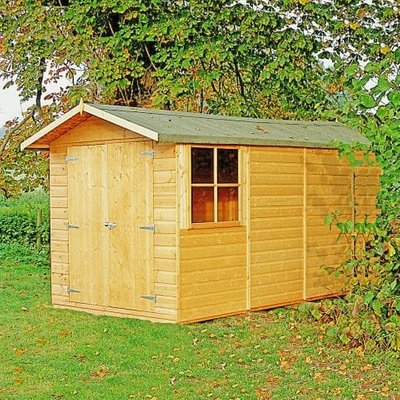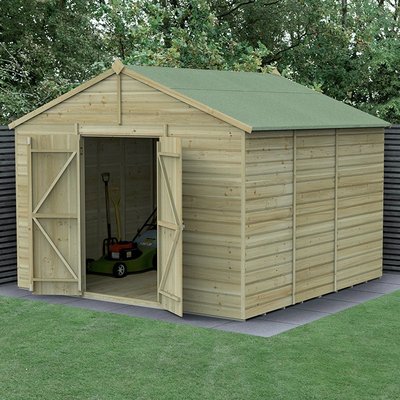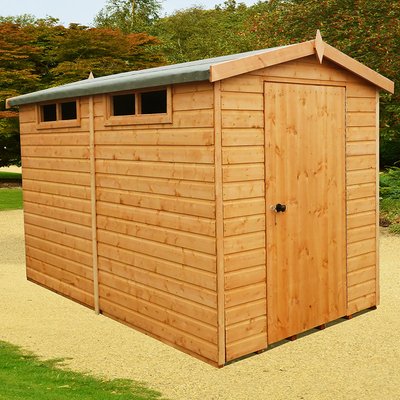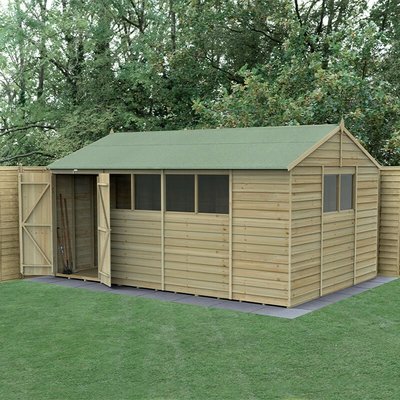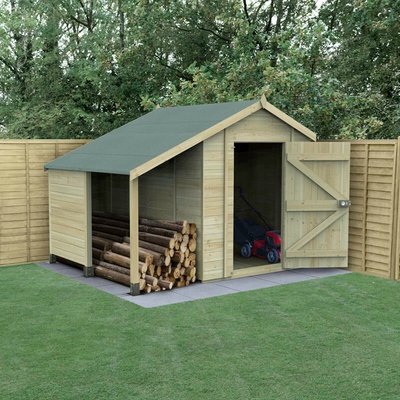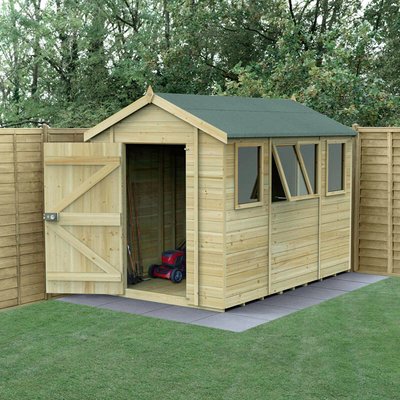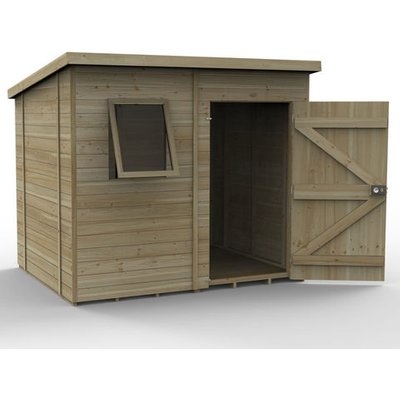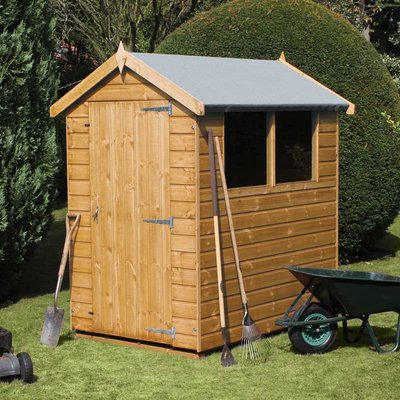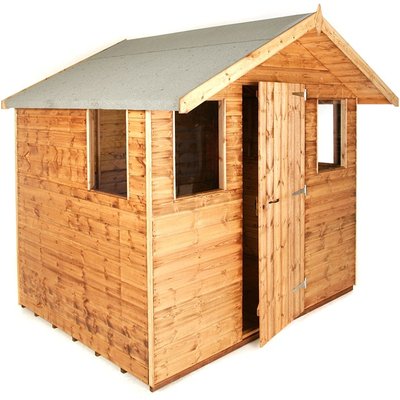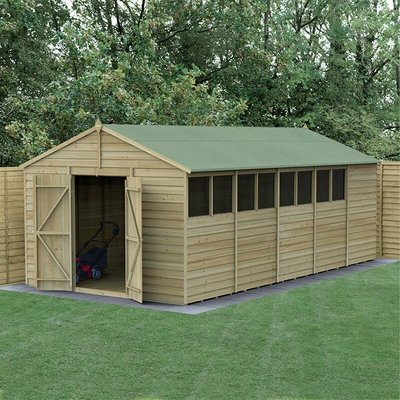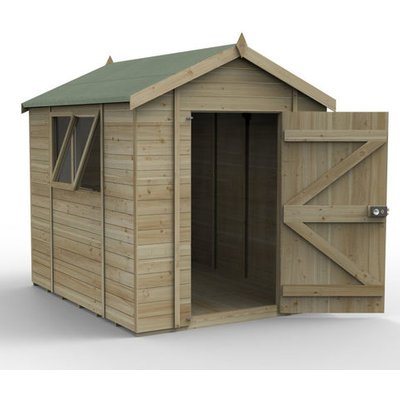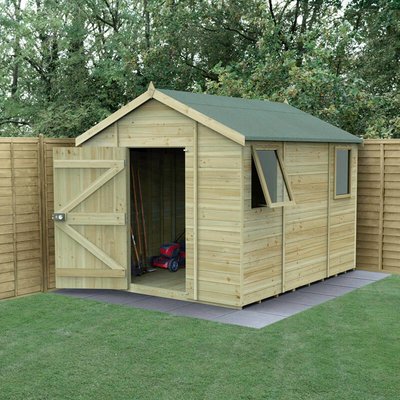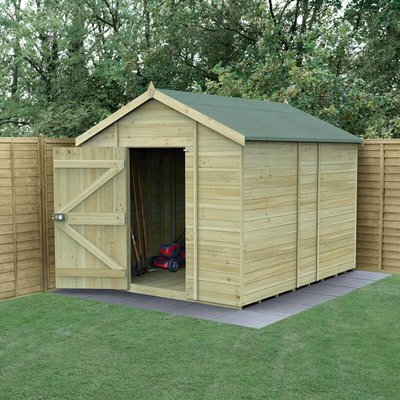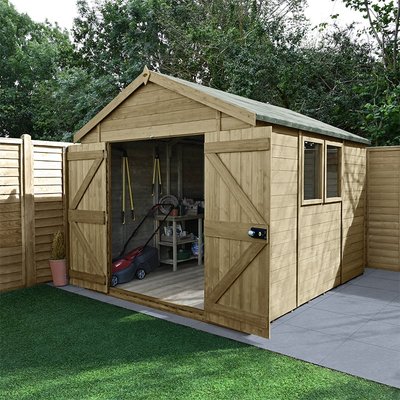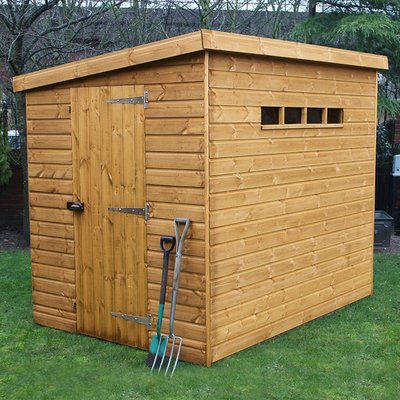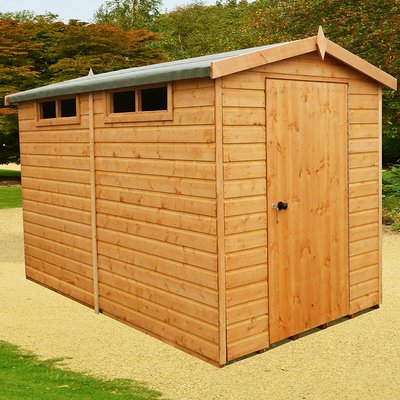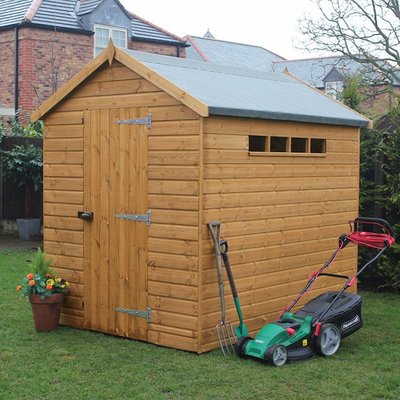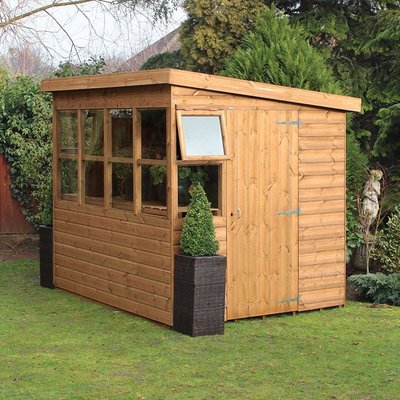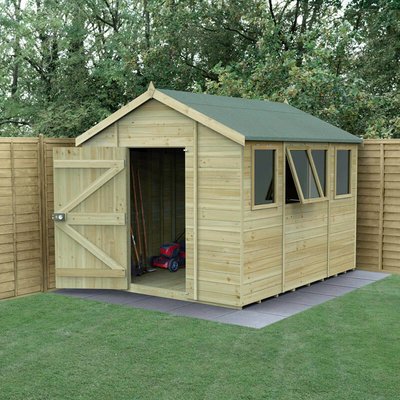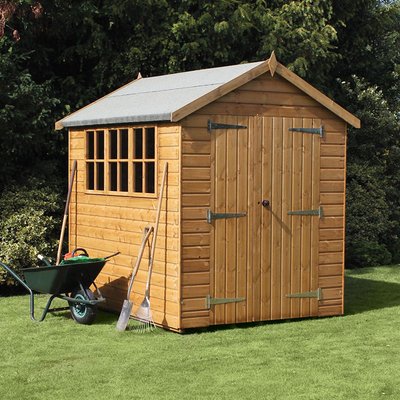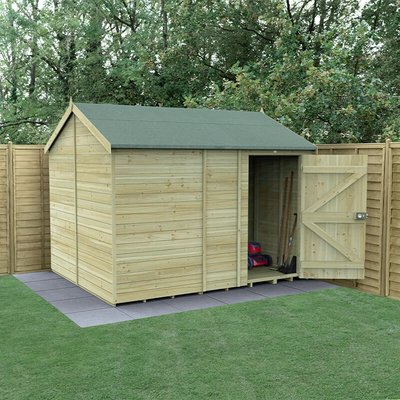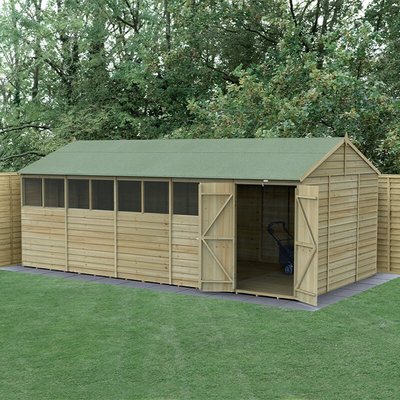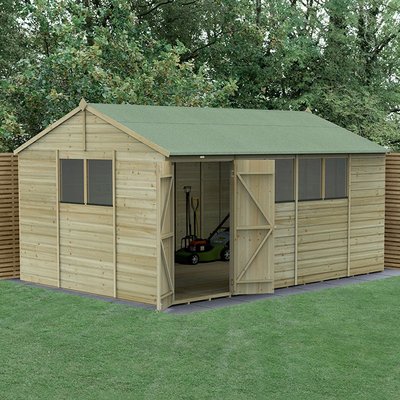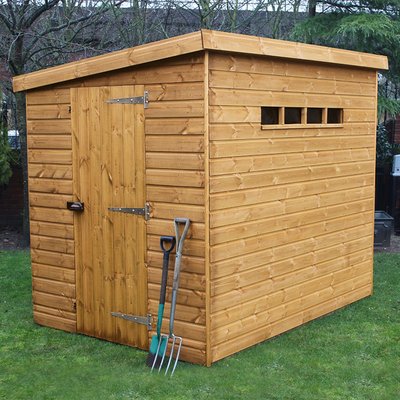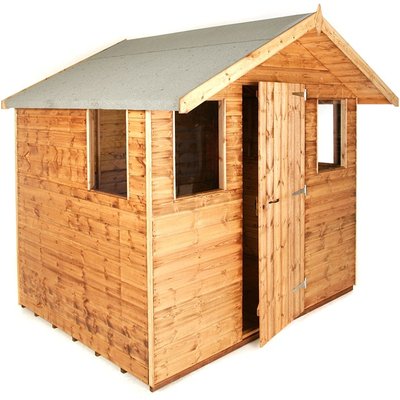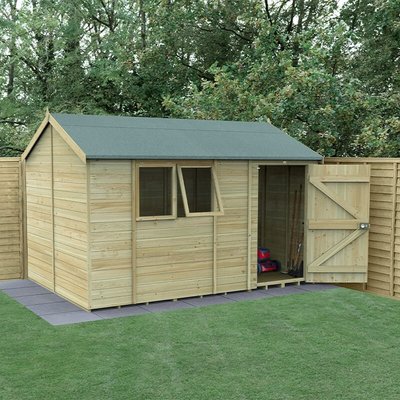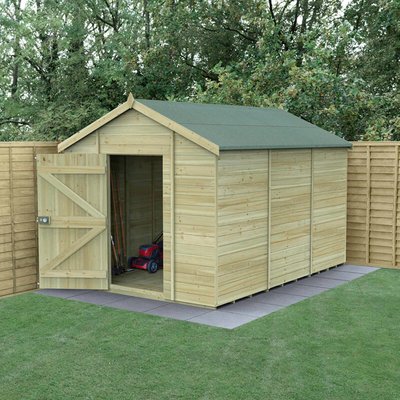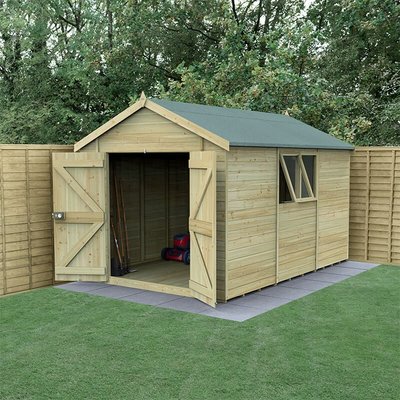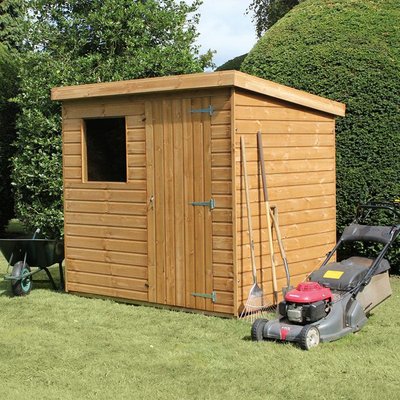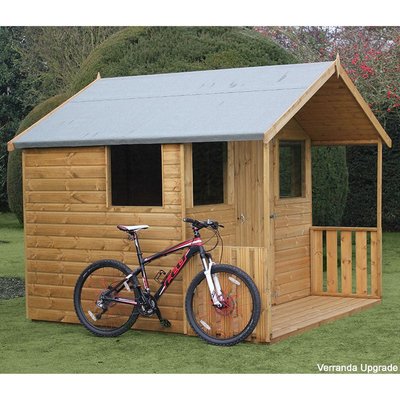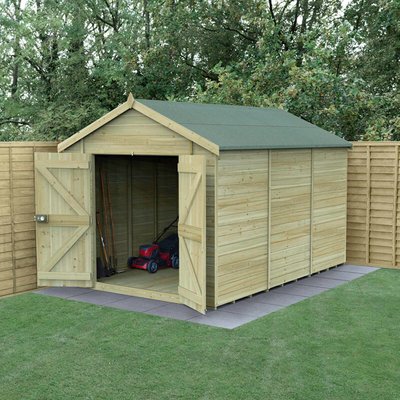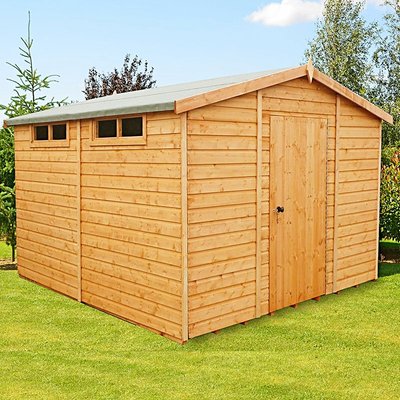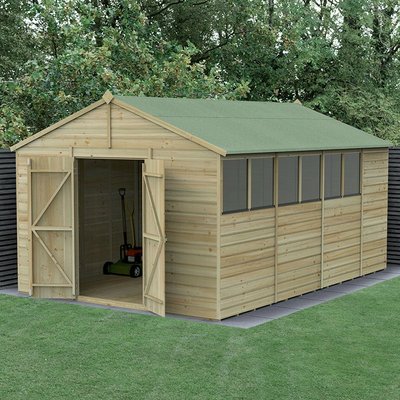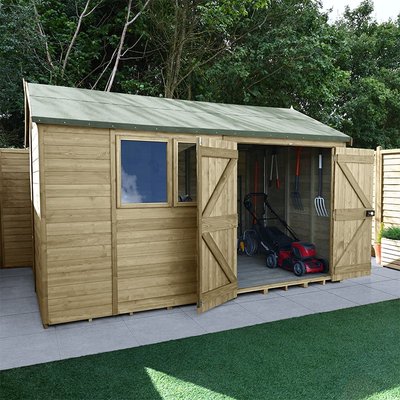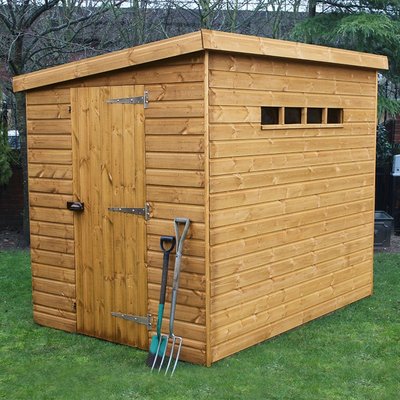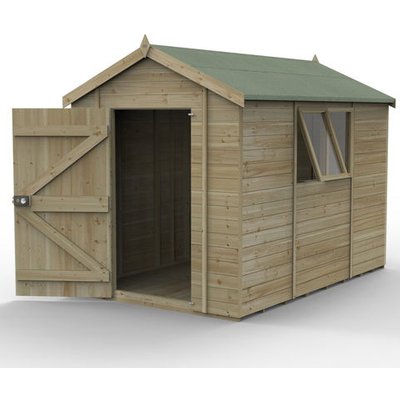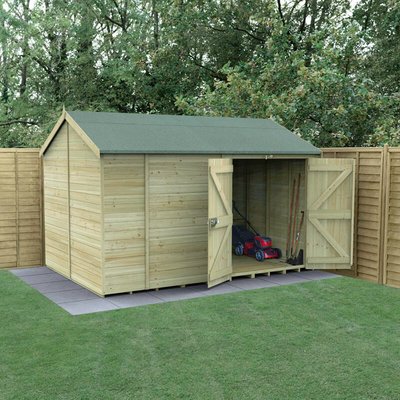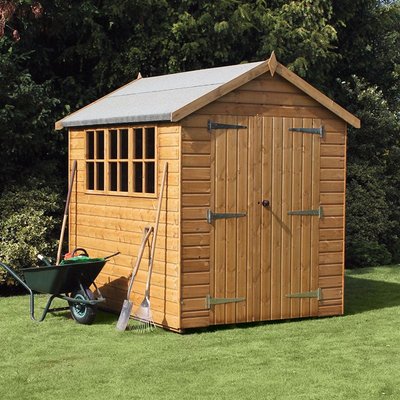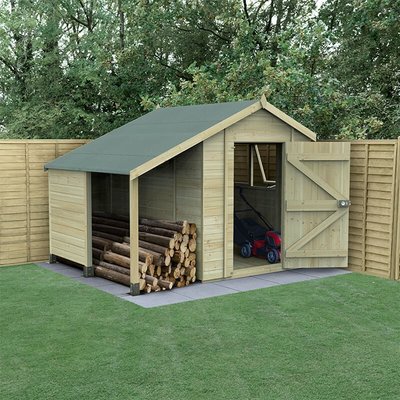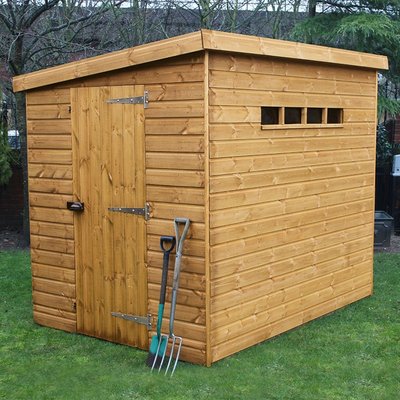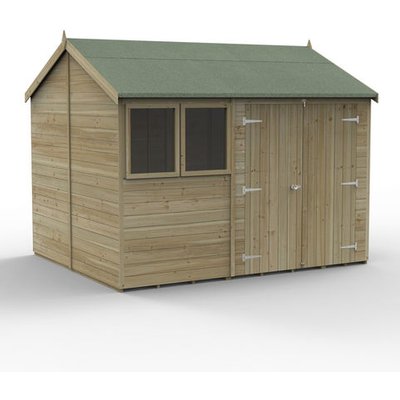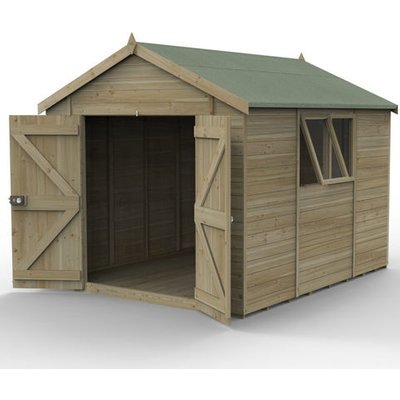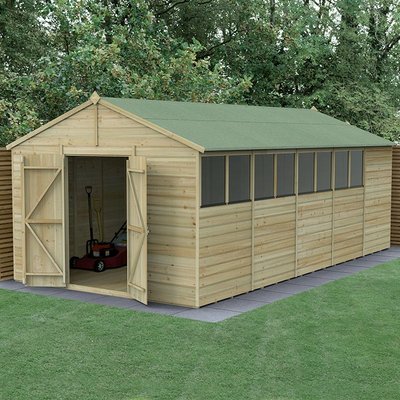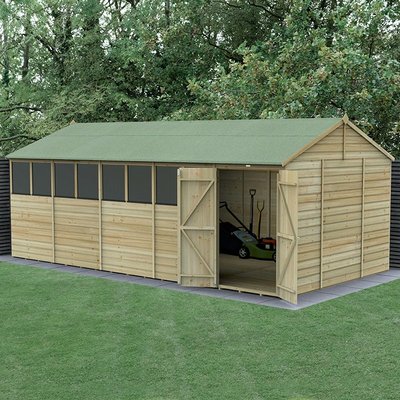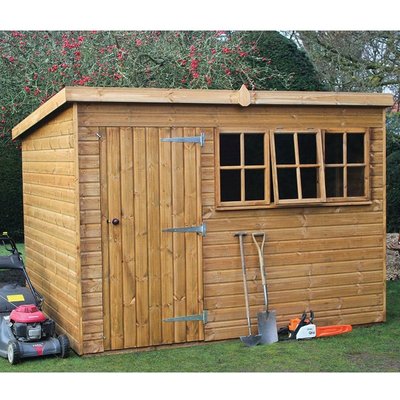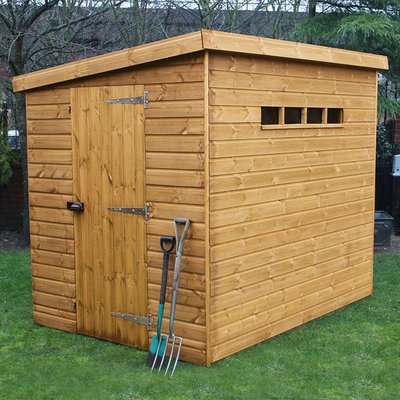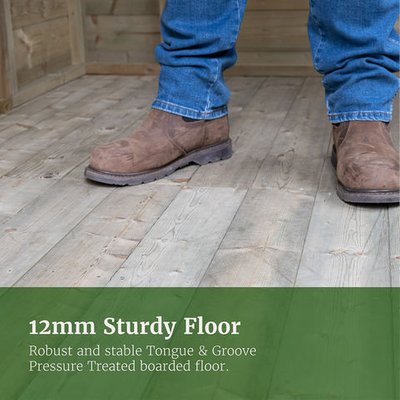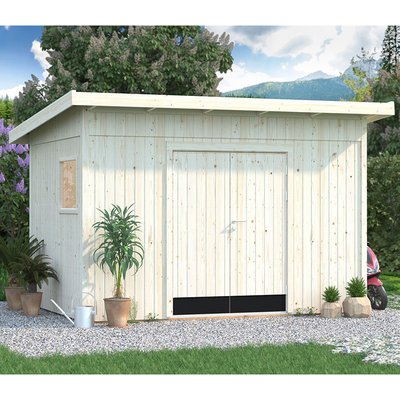Get the Most From Your Outdoor Space
Wooden Garden Sheds
 The
most popular material for sheds, affordable and blends
sympathetically into the garden more than any other
material, especially as the wood weathers with age. They are
easy to modify with shelves, locks etc.
The
most popular material for sheds, affordable and blends
sympathetically into the garden more than any other
material, especially as the wood weathers with age. They are
easy to modify with shelves, locks etc.
The wood used for sheds will always be treated with preservative,
dip treated is good, pressure treated is better.
The wood can be left as it is or additionally stained in a whole host of shades,
stained wood is subtle in a
way that other painted surfaces never can be.Which Cladding? - the material used for the walls of the shed
-
Weatherboard - is the cheapest, it is made of overlapping fence-type
boards. As the boards
are simply overlapped they can warp and knots may fall
out. Sometimes known as rustic-cladding.
Tongue and Groove planking - is better as the planks are held in place along the top and bottom edges giving a more weather-proof and cleaner planed finish.
Shiplap - a similar and less expensive version of tongue and groove, a rebate at the bottom of each plank overlaps the edge of the plank below.
Q. How do I calculate a template to ensure the corners for my shed base are square? the size of the base is 14ft X 10 ft
A. You could buy a "builders square" or "framing square" a large set square with arms about 18-24" long or alternatively make yourself a triangle with sides in the ratio 3:4:5 and you'll get a perfect right angle. Wood is the best material and can be whatever is to hand, just knock a nail or screw through the joints. The bigger the pieces the more accurate it is i.e. 3,4 and 5ft work better than 30, 40 and 50cm. You can check if you have it right by measuring the diagonals, if they are identical, then you have four right angles, if not, then start again! Mark out the base of the shed with pegs and string first before you start to dig it out and prepare the foundations.
Q. I have recently acquired a small build it yourself gardening shed. The problem is that the instructions did not in anyway account for the foundation of the small structure leaving the means up to myself. I was thinking simply cinder blocks and some pressure treated wood, but any suggestions that are cost efficient would be greatly appreciated.
A. You need to keep the wood of the shed out of the wet. The easiest way to do this is to level an area of earth the same size of the shed (don't dig any kind of an hollow in doing this) and then lay some kind of concrete/stone base. I use patio slabs for this, the cheapest compressed concrete sort are fine and also amongst the strongest - it doesn't matter what they look like under the shed. These are about 2 inches thick and do the job well. Cinder blocks are probably thicker than this and while perfectly acceptable may just raise the entrance a little above what you'd like, you could always dig them in a little though, use sand to level out the bottom of the holes with. Pressure treated wood should be unnecessary as the slabs alone should be enough to make sure the wood of the shed is not in contact with the wet ground.
Sheddy Thoughts
Many words have been written about sheds and how they are a male preserve. A cave to retreat to when we feel threatened. A place to keep all of our precious things, things so precious we daren't bring them into the house lest they be misunderstood by our womenfolk and thrown away.
There's something very boyish about sheds, the fact that ideally they're not that easy to see - they should be at least semi-hidden by bushes and other growth.
The path to a real shed should be somewhat ramshackle. Wonky left over paving slabs and bricks maybe, preferably a bit broken up and with long grass growing in-between. I went to the shed of the man who I buy firewood from recently to find that the last few feet were so muddy that you had to walk across a 4" wide plank to get to it - most impressive.
Maybe it's something to do with recreating the boyhood adventures of making a "den", dens and sheds both come from some primeval male instinct towards the secluded cave and to saving stuff.
 A
shed shouldn't attract attention, it shouldn't be too inviting
to the outsider (i.e. the rest of the world) it should
be full of things that make the owner feel comfortable and for
exactly those reasons make the outsider feel uncomfortable.
A shed is a favourite old scruffy pair of slippers, absolute
heaven if they belong to you, but unpleasantly off putting if
they don't.
A
shed shouldn't attract attention, it shouldn't be too inviting
to the outsider (i.e. the rest of the world) it should
be full of things that make the owner feel comfortable and for
exactly those reasons make the outsider feel uncomfortable.
A shed is a favourite old scruffy pair of slippers, absolute
heaven if they belong to you, but unpleasantly off putting if
they don't.
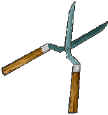 What
to keep in this shed then? Tools for a start, garden
and otherwise, a proper shed tool is perfectly serviceable but
preferably a bit rusty and with some history - Like the random
collection of old spanners that I've got in an old whiskey bottle
tin. I've got one spanner that I remember my granddad using
to adjust my bike when I was 7 or 8 and a really big shiny one
(ok so it's not perfect) that come to think of it , I probably
acquired from my dad. I can't ever remember him or me having
used it, but I used to love playing around with it when I was
little and it's the one my own son always picks up and waves
around when he spots it.
What
to keep in this shed then? Tools for a start, garden
and otherwise, a proper shed tool is perfectly serviceable but
preferably a bit rusty and with some history - Like the random
collection of old spanners that I've got in an old whiskey bottle
tin. I've got one spanner that I remember my granddad using
to adjust my bike when I was 7 or 8 and a really big shiny one
(ok so it's not perfect) that come to think of it , I probably
acquired from my dad. I can't ever remember him or me having
used it, but I used to love playing around with it when I was
little and it's the one my own son always picks up and waves
around when he spots it.
Sheds should have a collection of useful things in jars or in those cabinets with a dozen or more little plastic drawers. There should be a large amount of something almost brand new but a bit out of the ordinary and therefore basically useless to the average mortal, though far too good not to warrant proper respect.
 Personally I have a large collection of galvanized nails too
short to be used for regular nailing jobs, too small a head
to use for fixing roofing felt and too fat for where a panel
pin or similar would be used.
Personally I have a large collection of galvanized nails too
short to be used for regular nailing jobs, too small a head
to use for fixing roofing felt and too fat for where a panel
pin or similar would be used.
Unfortunately it is necessary sometimes to let others into this inner sanctum to store bikes or gain access to things such as a hose pipe or watering can. This can be largely avoided by keeping these things in the back of the garage (sometimes known as the "poor mans shed"), that is not so personal a space.
The back of a garage is also a better place to store things like new tools or unopened tins of paint / varnish etc. that have not earned their place in the shed due to a lack of familiarity. In due course having gained provenance, they may be upgraded to shed worthiness.
It is allowable to permit children to enter the shed, so as to pass on the legacy and instill the sense of awe that a well stocked and mature shed can bring.Things to keep in your shed
![]() Items of personal historic interest
but no intrinsic value whatsoever.
Items of personal historic interest
but no intrinsic value whatsoever.
![]() Assorted machinery that is slightly
broken though perfectly repairable once you get
around to it.
Assorted machinery that is slightly
broken though perfectly repairable once you get
around to it.
![]() Bits of wood of all kinds that
are far more valuable from a distance than in close
up.
Bits of wood of all kinds that
are far more valuable from a distance than in close
up.
![]() Garden tools.
Garden tools.
![]() Bicycles belonging to the rest
of the family (grudgingly).
Bicycles belonging to the rest
of the family (grudgingly).
![]() Almost full bags of almost gone-off
cement and damp granular fertiliser that is now
in a single 10kg lump.
Almost full bags of almost gone-off
cement and damp granular fertiliser that is now
in a single 10kg lump.
The best sheds
![]() Are not easily visible at first glance.
Are not easily visible at first glance.
![]() At second glance appear abandoned,
even derelict.
At second glance appear abandoned,
even derelict.
![]() Don't have good paths to them.
Don't have good paths to them.
![]() Have a fascinating collection of varied contents,
similar to that obtained in a 60 second "supermarket
dash" around a diy shop about 25 years ago.
Have a fascinating collection of varied contents,
similar to that obtained in a 60 second "supermarket
dash" around a diy shop about 25 years ago.
![]() Have a comfy chair.
Have a comfy chair.
![]() Have some form of heating and tea making facilities
Have some form of heating and tea making facilities
A man's shed is a window to his soul - Aristotle
Copyright 2000 - present. All Rights Reserved | Privacy Policy Statement














